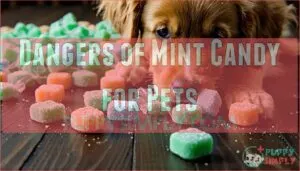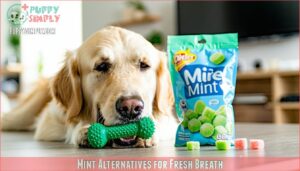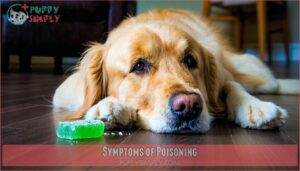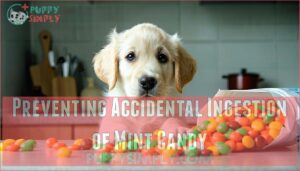This site is supported by our readers. We may earn a commission, at no cost to you, if you purchase through links.

Many mint candies contain xylitol, an artificial sweetener that’s toxic to dogs and can cause dangerous drops in blood sugar, seizures, and even liver failure.
Even xylitol-free mint candies pose risks – hard candies are choking hazards, while sugar and other ingredients can lead to obesity and dental problems.
Your pup’s curious nose might be drawn to that minty freshness, but it’s simply not worth the risk.
If your dog accidentally snatches a mint candy, watch for symptoms like vomiting, loss of coordination, or lethargy – these might indicate you need immediate veterinary attention.
Table Of Contents
- Key Takeaways
- Dangers of Mint Candy for Pets
- Other Mint Products to Avoid
- Safe Forms of Mint for Pets
- Benefits of Spearmint for Pets
- How Much Spearmint Can Pets Have?
- Mint Alternatives for Fresh Breath
- What to Do if Your Pet Eats Mint Candy
- Preventing Accidental Ingestion of Mint Candy
- Frequently Asked Questions (FAQs)
- Can dogs eat mints?
- Can dogs eat cashews?
- Can dogs eat peppermint candy?
- Can dogs eat mint ice cream?
- Can dogs eat candy?
- Can dogs eat pennyroyal mint?
- Are Other Mint Products Besides Candy Toxic to Pets?
- Are There Any Alternatives to Mint for Freshening My Pet’s Breath?
- What Should I Do if I Think My Pet Has Eaten Mint Candy?
- How Can I Prevent My Pet From Accidentally Ingesting Mint Candy?
- Conclusion
Key Takeaways
- Never give your dog mint candy as it often contains xylitol, an artificial sweetener that can cause dangerous drops in blood sugar, seizures, and liver failure within minutes of consumption.
- Keep all mint products including mint oil, mint sauce, and mint ice cream away from your pet as they contain concentrated oils, xylitol, or high sugar content that can cause serious health issues.
- If your dog accidentally eats mint candy, watch for symptoms like vomiting, lethargy, or loss of coordination and seek immediate veterinary care—don’t wait for symptoms to worsen.
- Fresh or dried spearmint leaves (1-2 leaves daily) are safe alternatives that can improve your dog’s dental health, aid digestion, and naturally freshen their breath without the dangers of commercial mint products.
Dangers of Mint Candy for Pets
You’ll need to watch out for mint candies in your home, as they often contain xylitol, a sweetener that can cause liver failure and seizures in dogs.
What might give you a pleasant after-dinner freshness can trigger dangerous low blood sugar and potentially fatal reactions in your furry friend within minutes of ingestion.
Xylitol Poisoning
Inside many sugar-free mint candies lurks xylitol, a sweetener that’s deadly toxic to dogs.
Even tiny amounts can trigger a dangerous insulin release, causing severe xylitol poisoning within 30 minutes of ingestion.
This artificial sweetener damages your dog’s liver and can lead to fatal complications.
Always check labels for "xylitol," "birch sugar," or "E967" on mint candy wrappers—these hidden toxicity sources require immediate veterinary treatment if consumed.
Sour candies also pose a threat, given their potential citric acid.
Low Blood Sugar
Within minutes of your dog eating mint candy containing xylitol, a dangerous chain reaction begins.
This sweetener triggers insulin overproduction, causing glucose absorption from the bloodstream at an alarming rate.
Without cellular energy from glucose, your dog can develop hypoglycemia symptoms including weakness, stumbling, and collapse.
Even small amounts – just one or two pieces of candy – can drop blood sugar to life-threatening levels.
The speed of xylitol poisoning makes it particularly dangerous, often causing symptoms before you’ve even realized what your pet has eaten.
Dietary management after exposure requires immediate veterinary intervention to stabilize blood sugar levels.
Liver Failure
Xylitol in mint candy can devastate your dog’s liver within hours.
This artificial sweetener triggers a dangerous cascade where liver enzymes skyrocket and essential functions shut down.
Watch for jaundice symptoms—yellowing eyes and gums—alongside lethargy and vomiting.
Treatment options include IV fluids and medications to support liver function, but recovery depends on how quickly you seek help.
The long-term effects of xylitol poisoning can be permanent, with some dogs requiring lifelong medication.
Don’t gamble with your pet’s health—mint candy simply isn’t worth the risk.
Seizures
Seizures represent one of the most frightening consequences of xylitol poisoning in dogs who consume mint candy.
When your dog ingests xylitol-containing mints, seizures can occur within 30-60 minutes after consumption.
These seizures may last several minutes and require immediate emergency vet care.
Post-seizure care is critical, as these episodes can cause brain damage. Anti-seizure meds might be necessary if you can’t reach a veterinarian quickly during this toxicity crisis.
Other Mint Products to Avoid
You’ll need to watch out for more than just mint candies when protecting your furry friend from harm.
Mint oil, mint sauce, and mint ice cream contain ingredients like concentrated oils, xylitol, and high sugar content that can lead to serious health problems in your dog.
From digestive issues to potential organ damage, these health problems can have severe consequences for your furry friend.
Mint Oil
While candy poses risks, mint oil is even more dangerous for your four-legged friend.
Peppermint oil’s concentrated nature makes it highly toxic to dogs, causing serious health issues through:
- Direct ingestion leading to severe gastrointestinal distress
- Skin exposure causing irritation and potential absorption
- Inhalation from diffusers creating breathing problems
Even small amounts can trigger vomiting, drooling, difficulty breathing, and in severe cases, life-threatening seizures.
Keep all essential oils, especially peppermint, safely stored where curious paws can’t reach them.
Mint Sauce
Many commercial mint sauces pose serious risks to your furry friend.
These condiments typically contain vinegar, sugar, and sometimes grape-based ingredients that can lead to kidney failure in dogs.
Mint sauce ingredients often include artificial sweeteners like xylitol, which causes mint toxicity in dogs within minutes of consumption.
When investigating mint poisoning in dogs, veterinarians first ask about exposure to mint sauce or similar products.
The preparation methods for mint sauce involve concentrating mint oils, making them more dangerous than fresh leaves.
Even homemade versions with natural mint can cause upset stomachs due to their potency.
While mint sauce has historical significance in many cuisines, it offers no nutritional benefits for canines.
If your dog accidentally consumes mint sauce, monitor for vomiting, diarrhea, or lethargy—all signs requiring immediate veterinary attention.
Always keep such condiments safely stored away from curious paws.
Mint Ice Cream
While mint sauce poses risks, mint ice cream brings its own set of dangers for your four-legged friend.
That creamy, minty treat you enjoy might seem like a nice way to cool your pup down, but it’s actually a triple threat.
The lactose in dairy products can cause digestive upset in many dogs who are lactose intolerant.
Add to that the high sugar content that contributes to weight gain and potential diabetes, plus artificial flavors that may trigger adverse reactions.
Some mint ice creams might even contain xylitol, which causes severe toxicity in dogs.
Even small serving sizes can lead to dangerous drops in blood sugar and liver failure.
If your dog seems interested in that cool, invigorating taste, try safe alternatives instead.
Freeze dog-friendly fruits like watermelon or use specially formulated "doggy ice cream" that won’t harm your pet.
Remember, when dogs eat candy or human desserts, the risks simply aren’t worth the brief enjoyment.
Safe Forms of Mint for Pets
You’ll be relieved to know that fresh and dried spearmint leaves are safe for your furry friend in small quantities.
These natural mint options can actually help with digestion and freshen your pet’s breath without the dangerous ingredients found in commercial mint candies, making them a great alternative with natural benefits.
Fresh Spearmint
Unlike toxic mint candy, fresh spearmint leaves are completely safe for your dog when offered in appropriate amounts. Dogs can safely consume one or two fresh spearmint leaves daily, making it an excellent natural option for fresher breath.
Growing spearmint at home guarantees you have a pet-safe herb readily available. This herb contains valuable nutrients including vitamin A, antioxidants, and manganese that support your dog’s overall health.
Many spearmint varieties are safe, but always verify you’re not giving your pet pennyroyal mint, which is highly toxic to dogs. You can easily find quality spearmint for your pet’s needs.
Some commercial dog foods already incorporate spearmint for its digestive benefits and pleasant flavor. For spearmint storage, keep fresh leaves refrigerated to maintain their nutritional value. Remember, moderation is key when dogs eat mint in any form.
Dried Spearmint
Carefully dried and stored properly, dried spearmint leaves offer your dog the same benefits as fresh leaves, just in a more concentrated form.
While dogs can eat mint safely in this dried version, you’ll need to reduce the portion size compared to fresh leaves. Simply sprinkle a small amount into your dog’s food a few times weekly—one chopped leaf is typically sufficient.
The drying process actually preserves many of spearmint’s medicinal uses and tea benefits. You can include dried spearmint in recipes for homemade dog treats, but remember that moderation is key.
Too much can cause stomach upset in canines and mint consumed in large quantities might lead to vomiting and diarrhea. Consider purchasing dried spearmint products specifically designed for canine consumption.
Before introducing any mint to your furry friend, it’s always wise to consult your vet about potential mint toxicity for dogs.
Benefits of Spearmint for Pets
While mint candy can harm your dog, fresh spearmint leaves offer nutritional benefits like vitamins, antioxidants, and minerals that support your pet’s health.
You’ll find that adding small amounts of spearmint to your dog’s diet can improve their dental health, aid digestion, and even help freshen their breath naturally, which can be seen as a way to improve their overall health.
Nutritional Value
While mint candy is dangerous for your furry friend, safe forms of spearmint offer impressive nutritional benefits for dogs.
Spearmint leaves contain a treasure trove of nutrients that support your dog’s overall health.
The leaf benefits include vitamin A, which promotes healthy vision and strengthens your dog’s immune system.
Unlike harmful mint candy, spearmint minerals like manganese contribute to strong bones, while potassium helps maintain healthy blood pressure levels in your canine companion.
The antioxidants in spearmint leaves work to reduce inflammation and protect against cell damage, supporting long-term dog health.
Vitamin C, another key component, boosts your pet’s immune system and aids in wound healing through improved collagen production.
For ideal canine nutrition, remember that safe amounts of fresh or dried spearmint (1-2 leaves daily) can complement your dog’s diet without the dangers of commercial mint products.
When considering treat alternatives, natural spearmint leaves offer nutritional value without added sugars or artificial ingredients.
Dental Health
Chewing spearmint leaves offers remarkable dental benefits for your dog, naturally reducing plaque buildup and controlling tartar.
Chewing spearmint leaves helps freshen your dog’s breath naturally while reducing plaque buildup and supporting healthy gums.
Unlike toxic mint candy, which can harm dogs severely, small amounts of fresh spearmint promote gum health while freshening breath.
Veterinarians recommend incorporating safe chews as part of regular dog dental care routines. To maintain peak health, consider scheduling annual dental checkups.
The natural antibacterial properties in spearmint help maintain oral hygiene without the dangers associated with commercial mint products that could damage your pet’s teeth and overall health.
Digestive Health
Adding spearmint to your dog’s diet, in small amounts, can work wonders for their digestive health. This bright herb supports gut bacteria balance, assists enzyme production, and promotes better nutrient absorption.
Thanks to its natural properties, spearmint keeps your dog’s intestinal motility in check, which can help with bloating remedies and overall digestive tract comfort.
But don’t confuse spearmint with products like mint candy for dogs. Sugary treats or sugar-free varieties containing xylitol are toxic and strictly off-limits.
Letting dogs eat peppermint candy or similar snacks is a recipe for gastrointestinal issues, so stick to safer options. If you’re unsure, consult your vet—they’ll help you make the best choices for your pup’s belly!
Blood Pressure
Spearmint isn’t just for fresh breath—it may support your dog’s heart health by helping reduce blood pressure.
While mint candy dogs adore might be dangerous, the natural benefits of spearmint can be a safer choice. Always monitor portions to avoid overfeeding.
- Supports canine heart health by lowering hypertension risks.
- Small amounts may aid in blood pressure monitoring naturally.
- Unlike peppermint candy dogs, spearmint offers safe benefits without harmful additives.
How Much Spearmint Can Pets Have?
The Daily Spearmint Limit for dogs depends on their size and breed, so check with your vet first. One or two fresh spearmint leaves a day is safe for most dogs.
Watch out for Mint Toxicity Levels—too much spearmint can cause vomiting or diarrhea.
- Chop leaves into small pieces to prevent choking.
- Verify it’s spearmint, not toxic pennyroyal.
- Avoid giving spearmint to dogs prone to GI issues.
- Never confuse fresh spearmint with mint candy—dogs and peppermint candy don’t mix, as this can lead to serious health problems due to toxic reactions.
Mint Alternatives for Fresh Breath
You don’t have to rely on risky mint candy to keep your dog’s breath fresh.
Safer options like dental treats and chew toys are great for promoting oral hygiene while keeping your pet happy and healthy.
Dental Treats
Keeping your dog’s breath fresh doesn’t have to be sweetened with sugary, minty candies that could harm them. Instead, treat them to dental treats specifically made to promote dental health while keeping safety in mind.
These treats are designed to reduce plaque buildup, freshen breath, and support oral hygiene. Most are chewable and include healthy ingredients like parsley extract or chlorophyll for natural breath freshening.
You can find a variety of effective dental products online. Check this quick comparison before heading to the pet aisle:
| Feature | Safe for Dogs? | Benefits |
|---|---|---|
| Parsley Extract | Yes | Freshens breath naturally |
| Chlorophyll | Yes | Reduces mouth odor and supports gums |
| Cocoa Products | No | Toxic to dogs, even in tiny amounts |
| Xylitol-Free Options | Yes | Safer for sensitive systems |
| Vet-Recommended Brands | Yes | Tested for ideal dental health |
Remember, even with dental treats, brushing your dog’s teeth weekly with a vet-recommended toothpaste helps maximize their oral health. If bad breath doesn’t improve, reach out to your vet to rule out other health problems.
Chew Toys
If you’re worried about mint candy posing risks like choking hazards or intestinal blockage for your dog, chew toys are a great alternative.
Opt for durable options made from safe materials that are designed to clean teeth and freshen breath. Many toys include natural ingredients like parsley or mint to fight odors while offering dental benefits.
Chewing also keeps curious pups busy, helps reduce boredom, and strengthens jaw muscles. For heavy chewers, durable nylon toys are often recommended.
Be sure to choose chew toy sizes that match your dog’s breed and avoid anything small enough to swallow. Interactive toys add a layer of engagement, keeping your pup happy and healthy this holiday season.
With the right toys, you’ll skip the risks and make playtime safe and invigorating!
What to Do if Your Pet Eats Mint Candy
If your dog eats mint candy, you’ll need to act quickly to protect their health.
Knowing the symptoms of poisoning and when to call the vet can make all the difference.
Symptoms of Poisoning
If your dog eats mint candy, watch for signs of toxicity.
Common symptoms include vomiting, diarrhea, and abdominal pain, which can occur from toxic ingredients like xylitol or concentrated mint oil.
Lethargy and a noticeable loss of appetite often follow poisoning, signaling that something’s wrong.
Pay attention to these red flags:
- Vomiting or diarrhea: These can signal poisoning or gastrointestinal upset.
- Lethargy and weakness: A sign your pet’s energy is draining due to poisoning.
- Abdominal pain: Dogs may show discomfort by whining or avoiding movement.
- Appetite loss: Skipping meals could point to toxicity or digestive trouble.
Stay vigilant if your dog shows these symptoms, as mint candy can cause severe harm quickly.
Emergency Vet Care
If your dog eats mint candy, especially those packed with xylitol, immediate action is critical.
Emergency vet care can save their life, so don’t delay. Call your vet or an emergency specialist right away for advice. Depending on the situation, they might suggest inducing vomiting or using activated charcoal to limit toxin absorption. Supportive care, like IV fluids and medications, can help stabilize your dog.
Here’s what to expect during emergency care:
| Step | Description |
|---|---|
| Inducing Vomiting | Removes the candy to prevent further absorption. |
| Activated Charcoal | Binds toxins in the stomach, reducing their effect. |
| Monitoring Health | Tracks heart rate, breathing, and overall health. |
| Prognosis Factors | Evaluates recovery chances based on injury extent. |
Early intervention makes the prognosis better. Always follow veterinary advice, and remember: toxic foods like mint candy aren’t worth the risk.
Preventing Accidental Ingestion of Mint Candy
You can easily prevent your dog from accidentally eating mint candy by keeping it securely out of reach in cabinets or sealed containers.
Make sure to properly dispose of candy wrappers, as curious pets might mistake them for tasty treats, and ensure that all candy is handled in a way that prevents accidental consumption.
Keeping Candy Out of Reach
You’ve checked for symptoms and called your vet, but prevention is your best bet.
Mint candy, especially those containing xylitol, is a severe hazard for dogs.
To keep your furry friend safe, focus on secure storage.
Use elevated shelves, locked cabinets, or other pet-proofing strategies to keep treats out of reach.
Think of it like child safety—curious noses find trouble fast!
Extra caution is needed with sweet-smelling items like candles or oils.
Sour candies also pose a threat because of potential xylitol poisoning.
Prioritizing pet safety means always staying a step ahead of their mischief.
Proper Disposal of Candy Wrappers
The proper disposal of candy wrappers isn’t just about tidiness—it’s a critical pet safety measure that many owners overlook. Candy wrappers pose serious wrapper hazards for curious dogs, potentially causing intestinal blockages requiring emergency surgery.
To guarantee proper disposal and minimize choking hazard risks:
- Place all wrappers immediately in covered trash containers your pet can’t access
- Consider using designated recycling options for appropriate wrapper materials when available
- Compact multiple wrappers together before disposal to reduce landfill impact
- Check outdoor areas after gatherings where candy may have been consumed
Environmental impact concerns shouldn’t overshadow pet safety—many wrappers contain scent residues that attract pets long after the candy is gone. The crinkly texture and shiny appearance make them particularly enticing to dogs who might ingest them. When disposing of mint candy packaging, remember that a moment of prevention prevents potential veterinary emergencies.
Frequently Asked Questions (FAQs)
Can dogs eat mints?
Mints aren’t safe for dogs because they often contain xylitol, a sweetener that’s highly toxic.
Even small amounts can cause seizures, liver damage, or worse.
Stick to dog-safe treats, and keep mints out of reach.
Can dogs eat cashews?
Wondering if cashews are safe for your furry friend?
Yes, they’re safe in moderation.
You can give your dog plain, unsalted cashews occasionally as treats, but don’t overdo it due to their high fat content.
Can dogs eat peppermint candy?
No, don’t give your dog peppermint candy.
It’s dangerous for them as it may contain xylitol, which is toxic and potentially fatal.
The menthol in peppermint can also cause digestive issues and discomfort.
Can dogs eat mint ice cream?
Over 70% of mint ice creams contain xylitol, which is toxic to dogs.
You shouldn’t feed your dog mint ice cream as it can cause stomach upset, potential xylitol poisoning, and contains too much sugar and lactose.
Can dogs eat candy?
No, dogs shouldn’t eat candy.
It often contains toxic ingredients like xylitol that can cause serious health issues including liver failure.
Even regular sugar and artificial colors can upset your dog’s stomach and cause digestive problems.
Can dogs eat pennyroyal mint?
An ounce of prevention is worth a pound of cure.
Never give your dog pennyroyal mint – it’s highly toxic and can cause severe vomiting, seizures, and potentially death.
Contact your vet immediately if ingestion occurs.
Are Other Mint Products Besides Candy Toxic to Pets?
Yes, several mint products can harm your pets.
Essential oils, diffusers, and xylitol-containing mint items are toxic to dogs.
Peppermint oil and pennyroyal mint specifically can cause vomiting, seizures, and liver damage if ingested.
Are There Any Alternatives to Mint for Freshening My Pet’s Breath?
Barking up the right tree, you’ll find safer alternatives for fresh breath in your pet: dental chews, parsley, coconut oil, carrots, or specialized pet toothpaste.
These won’t harm your furry friend like mint candy would.
What Should I Do if I Think My Pet Has Eaten Mint Candy?
Contact your vet immediately if your pet eats mint candy.
Monitor for vomiting, diarrhea, lethargy, or seizures.
Keep the packaging to identify ingredients, especially if it contains xylitol, which is highly toxic.
How Can I Prevent My Pet From Accidentally Ingesting Mint Candy?
Store mint candies in sealed containers and high cabinets.
You’ll want to keep trash secure and educate family members about the dangers.
Always check ingredient lists for xylitol, which is extremely toxic to pets.
Conclusion
Like a candy jar on a high shelf, mint candies should remain safely out of your dog’s reach.
While some mint plants offer health benefits, mint candy can be deadly for your furry friend.
Remember, can dogs eat mint candy? Absolutely not—the risks far outweigh any momentary pleasure.
Instead, choose pet-safe breath fresheners and dental treats designed specifically for dogs.
Your vigilance today means a healthier, happier companion tomorrow, free from preventable emergencies and heartache.
- https://www.themelrosevet.com/
- https://www.mayoclinic.org/diseases-conditions/acute-liver-failure/symptoms-causes/syc-20352863
- https://www.ncbi.nlm.nih.gov/pmc/articles/PMC7140474/
- https://pangovet.com/?utm_source=dogster&utm_medium=article&utm_campaign=dog_eat_drink
- https://www.aspca.org/pet-care/animal-poison-control/toxic-and-non-toxic-plants/mint
















